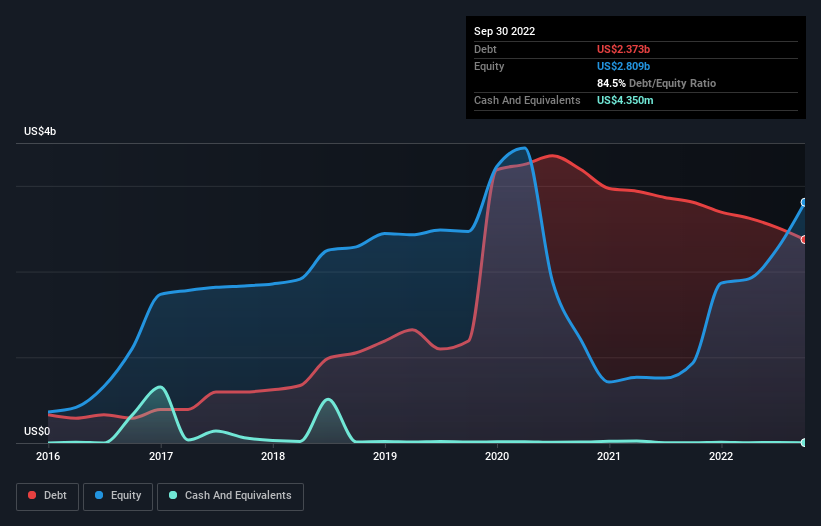- United States
- /
- Oil and Gas
- /
- NYSE:CPE
Callon Petroleum (NYSE:CPE) Takes On Some Risk With Its Use Of Debt
Warren Buffett famously said, 'Volatility is far from synonymous with risk.' When we think about how risky a company is, we always like to look at its use of debt, since debt overload can lead to ruin. Importantly, Callon Petroleum Company (NYSE:CPE) does carry debt. But the real question is whether this debt is making the company risky.
When Is Debt Dangerous?
Debt and other liabilities become risky for a business when it cannot easily fulfill those obligations, either with free cash flow or by raising capital at an attractive price. If things get really bad, the lenders can take control of the business. While that is not too common, we often do see indebted companies permanently diluting shareholders because lenders force them to raise capital at a distressed price. By replacing dilution, though, debt can be an extremely good tool for businesses that need capital to invest in growth at high rates of return. The first thing to do when considering how much debt a business uses is to look at its cash and debt together.
Check out the opportunities and risks within the US Oil and Gas industry.
How Much Debt Does Callon Petroleum Carry?
You can click the graphic below for the historical numbers, but it shows that Callon Petroleum had US$2.37b of debt in September 2022, down from US$2.81b, one year before. And it doesn't have much cash, so its net debt is about the same.

How Healthy Is Callon Petroleum's Balance Sheet?
We can see from the most recent balance sheet that Callon Petroleum had liabilities of US$794.0m falling due within a year, and liabilities of US$2.50b due beyond that. On the other hand, it had cash of US$4.35m and US$285.6m worth of receivables due within a year. So its liabilities total US$3.00b more than the combination of its cash and short-term receivables.
When you consider that this deficiency exceeds the company's US$2.54b market capitalization, you might well be inclined to review the balance sheet intently. In the scenario where the company had to clean up its balance sheet quickly, it seems likely shareholders would suffer extensive dilution.
In order to size up a company's debt relative to its earnings, we calculate its net debt divided by its earnings before interest, tax, depreciation, and amortization (EBITDA) and its earnings before interest and tax (EBIT) divided by its interest expense (its interest cover). This way, we consider both the absolute quantum of the debt, as well as the interest rates paid on it.
Callon Petroleum's net debt is only 1.3 times its EBITDA. And its EBIT easily covers its interest expense, being 16.3 times the size. So you could argue it is no more threatened by its debt than an elephant is by a mouse. Better yet, Callon Petroleum grew its EBIT by 1,145% last year, which is an impressive improvement. That boost will make it even easier to pay down debt going forward. The balance sheet is clearly the area to focus on when you are analysing debt. But ultimately the future profitability of the business will decide if Callon Petroleum can strengthen its balance sheet over time. So if you're focused on the future you can check out this free report showing analyst profit forecasts.
But our final consideration is also important, because a company cannot pay debt with paper profits; it needs cold hard cash. So the logical step is to look at the proportion of that EBIT that is matched by actual free cash flow. Over the last three years, Callon Petroleum reported free cash flow worth 8.2% of its EBIT, which is really quite low. For us, cash conversion that low sparks a little paranoia about is ability to extinguish debt.
Our View
While Callon Petroleum's level of total liabilities has us nervous. To wit both its interest cover and EBIT growth rate were encouraging signs. We think that Callon Petroleum's debt does make it a bit risky, after considering the aforementioned data points together. That's not necessarily a bad thing, since leverage can boost returns on equity, but it is something to be aware of. There's no doubt that we learn most about debt from the balance sheet. But ultimately, every company can contain risks that exist outside of the balance sheet. Case in point: We've spotted 3 warning signs for Callon Petroleum you should be aware of, and 2 of them are concerning.
When all is said and done, sometimes its easier to focus on companies that don't even need debt. Readers can access a list of growth stocks with zero net debt 100% free, right now.
New: AI Stock Screener & Alerts
Our new AI Stock Screener scans the market every day to uncover opportunities.
• Dividend Powerhouses (3%+ Yield)
• Undervalued Small Caps with Insider Buying
• High growth Tech and AI Companies
Or build your own from over 50 metrics.
Have feedback on this article? Concerned about the content? Get in touch with us directly. Alternatively, email editorial-team (at) simplywallst.com.
This article by Simply Wall St is general in nature. We provide commentary based on historical data and analyst forecasts only using an unbiased methodology and our articles are not intended to be financial advice. It does not constitute a recommendation to buy or sell any stock, and does not take account of your objectives, or your financial situation. We aim to bring you long-term focused analysis driven by fundamental data. Note that our analysis may not factor in the latest price-sensitive company announcements or qualitative material. Simply Wall St has no position in any stocks mentioned.
About NYSE:CPE
Callon Petroleum
Callon Petroleum Company, an independent oil and natural gas company, focuses on the acquisition, exploration, and development of oil and natural gas properties in West Texas.
Good value with mediocre balance sheet.
Similar Companies
Market Insights
Community Narratives



